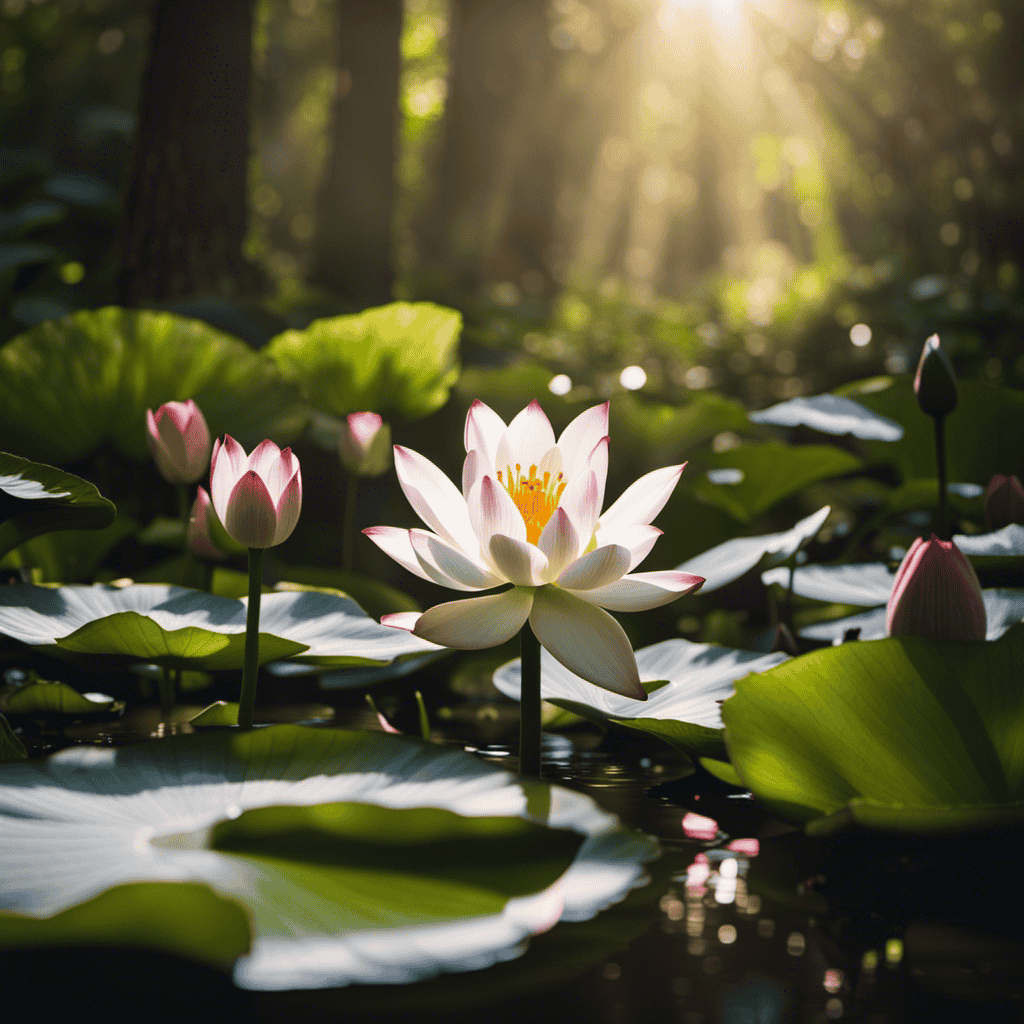In our quest for spiritual enlightenment, we frequently seek a means to access the divine essence within ourselves.
In the rich tapestry of ancient mantras, one stands out as a powerful symbol of cosmic energy and inner transformation: HARI OM.
This sacred chant, composed of two syllables, connects us to the divine essence of the universe and brings peace, harmony, and clarity of mind.
In this article, we will explore the meaning, history, and benefits of chanting HARI OM, and discover how it can unlock the divine within us.
Key Takeaways
- HARI OM is a Sanskrit mantra composed of two syllables, HARI and OM.
- Chanting HARI OM brings peace, harmony, and inner transformation.
- It is widely used in Hinduism, Buddhism, Jainism, yoga, and meditation.
- Chanting HARI OM connects us to the divine energy of the universe.
What is HARI OM?
HARI OM is a Sanskrit mantra composed of two syllables, HARI and OM, that is widely used in Hinduism, Buddhism, Jainism, yoga, and meditation. The significance of HARI OM varies across different religions.
In Hinduism, it is associated with the god Vishnu and the goddess Lakshmi, symbolizing the divine energy and abundance. In Buddhism, chanting HARI OM serves as a reminder of the impermanence of all things, leading to a deeper understanding of the Buddha’s teachings. In Jainism, HARI OM emphasizes our interconnectedness with the divine, promoting a sense of unity and oneness.
Chanting HARI OM also has profound effects on mental health. It has been found to reduce stress, anxiety, and depression, while increasing clarity of mind, concentration, and focus. By connecting us to the divine energy of the universe, HARI OM brings inner peace and harmony. It helps overcome obstacles and brings balance to our lives.
Whether practiced in daily life, yoga, or meditation, experiencing the transformative power of HARI OM is a journey towards unlocking the divine within ourselves.
Origin and History
I first learned about the origins and history of the HARI OM mantra when studying ancient Hindu texts like the Rig Veda and Upanishads. The significance and cultural impact of HARI OM are profound.
It is a mantra that has been chanted for thousands of years and is deeply rooted in Hinduism, Buddhism, and Jainism. Over time, the mantra has evolved and taken on variations in different traditions and practices.
In Hindu worship, meditation, and yoga, HARI OM is commonly used to connect to the divine energy of the universe and bring balance and harmony to one’s life. In Buddhism, it serves as a reminder of the impermanence of all things, while in Jainism, it emphasizes our interconnectedness with the divine.
The evolution and variations of HARI OM reflect the diverse spiritual practices and beliefs across these ancient traditions.
Benefits of Chanting
Chanting the HARI OM mantra has been shown to have numerous benefits for our overall well-being and mental health. The science behind chanting reveals that it can reduce stress, anxiety, and depression. When we chant HARI OM, it activates the relaxation response in our bodies, leading to a state of calm and inner peace. This repetitive vocalization also helps to increase the production of serotonin, a neurotransmitter that is associated with feelings of happiness and well-being.
In addition to the physiological effects, there are psychological benefits to chanting HARI OM. It helps to increase clarity of mind, concentration, and focus, allowing us to be more present in the moment. Chanting also brings awareness to our body, mind, and spirit, promoting a sense of self-awareness and mindfulness.
Overall, chanting the HARI OM mantra is a powerful tool for improving our mental and emotional well-being. It can help us to find balance, harmony, and inner peace in our daily lives.
Chanting in Practice
Practicing chanting HARI OM regularly has allowed me to experience a deep sense of inner peace and connection to the universe. The power of sound vibrations in this mantra is truly transformative. As I chant HARI OM, I can feel the vibrations resonating within me, creating a sense of harmony and balance. It is through these vibrations that I am able to connect with the divine energy of the universe.
Additionally, the role of breath in chanting is essential. As I take deep breaths and exhale while chanting HARI OM, I feel a sense of release and relaxation. It is through the breath that I am able to fully immerse myself in the mantra and let go of any stress or tension. The combination of sound vibrations and conscious breathing creates a powerful synergy that enhances the chanting experience.
In conclusion, chanting HARI OM with awareness of the power of sound vibrations and the role of breath has greatly enriched my practice. It has allowed me to tap into a deep sense of peace and connection, bringing harmony and balance to my life.
Incorporating in Daily Life
Incorporating the mantra HARI OM into my daily life has brought a sense of balance and harmony. Living with HARI OM: Daily Practices has allowed me to deepen my connection to the divine energy and find inner peace.
I start my day by chanting HARI OM for a few minutes, either out loud or silently, focusing on the energy it brings. Throughout the day, I use HARI OM as a tool to stay present and mindful, especially during difficult situations. By chanting the mantra, I am able to create a sense of balance, harmony, peace, and joy in my daily life.
Exploring the Energy of HARI OM has helped me to understand its deep symbolism and power. It is a reminder of the eternal vibration of the cosmos and the interconnectedness of all things.
Incorporating HARI OM into my daily life has truly transformed my experience and unlocked the divine within me.
Symbolism and Power
Exploring the symbolism and power of HARI OM has deepened my understanding of its transformative energy and connection to the universe. The symbolism behind HARI OM is profound and multi-layered, encompassing both spiritual and cosmic elements. The syllable "HARI" represents the Supreme Being and is associated with peace and abundance. It reminds us of the divine presence in our lives and the importance of cultivating inner peace. On the other hand, "OM" symbolizes the eternal vibration of the cosmos, representing the interconnectedness of all things. Chanting HARI OM connects us to this divine energy and helps us find balance, harmony, and well-being. It serves as a powerful tool for personal transformation, reducing stress, anxiety, and depression. By chanting HARI OM, I have experienced a profound sense of inner peace, joy, and connection to the universe. The transformative power of HARI OM is truly remarkable, and its impact on my daily life and spiritual practice is immeasurable.
| Symbolism | Power |
|---|---|
| HARI | Supreme Being, Peace, Abundance |
| OM | Eternal Vibration, Interconnectedness, Balance |
| Chanting HARI OM | Personal Transformation, Inner Peace, Connection to the Universe |
Experience the Transformation
Transitioning from the previous subtopic, where we explored the symbolism and power of the HARI OM mantra, now we delve into the transformative experience it offers.
As I personally chant HARI OM, I have come to understand that it is not merely a collection of syllables, but a pathway towards spiritual enlightenment. The resonance of this mantra resonates deep within, unlocking a sense of inner peace and harmony.
It is a profound journey, where the divine energy of HARI OM infuses every fiber of our being, guiding us towards a higher state of consciousness. The transformative power of HARI OM lies in its ability to connect us with the eternal vibration of the cosmos, allowing us to transcend the limitations of our human existence.
Through the practice of chanting HARI OM, we can experience a profound shift, where the noise of the external world fades away, and we are left with a profound sense of tranquility and unity with the universe.
Frequently Asked Questions
How can chanting HARI OM benefit my mental health?
Chanting Hari Om has been shown to benefit mental health through scientific research. It reduces stress, anxiety, and depression, increases clarity of mind, and promotes overall well-being. Many individuals have shared personal anecdotes of experiencing inner peace and transformation through chanting Hari Om.
Are there any specific rituals or practices associated with chanting HARI OM?
There are various Hari Om chanting techniques, such as focusing on the breath and maintaining concentration on the energy of the mantra. The role of intention in Hari Om chanting is crucial, as it helps to deepen the practice and connect with the divine energy.
Can chanting HARI OM help me overcome specific obstacles in my life?
Chanting Hari Om can lead to personal growth by helping me overcome obstacles in my life. It can also bring about spiritual transformation, deepening my connection with the divine and bringing positive changes.
What are some common misconceptions about the meaning and significance of HARI OM?
There are common misconceptions about the meaning and significance of Hari Om. Some misconceptions include its origins and symbolism. Additionally, people may overlook the physical healing and stress reduction benefits of chanting Hari Om.
Is there a specific time or place that is considered more auspicious for chanting HARI OM?
There is no specific time or place that is considered more auspicious for chanting HARI OM. However, many people choose to chant in the morning or during religious ceremonies, and some prefer to chant in sacred places like temples or meditation halls.
Conclusion
In conclusion, the practice of chanting HARI OM holds immense significance in various spiritual traditions. Its origin and history showcase its deep-rooted connection to Hinduism, Buddhism, and Jainism.
The benefits of chanting this mantra, such as reducing stress and promoting well-being, are widely acknowledged. Incorporating HARI OM into daily life, yoga, and meditation practices can bring balance and harmony.
Additionally, the symbolism and power behind this mantra emphasize our interconnectedness with the divine. It is ironic how such a simple chant can unlock the transformative power within us, connecting us to the eternal vibration of the cosmos.










